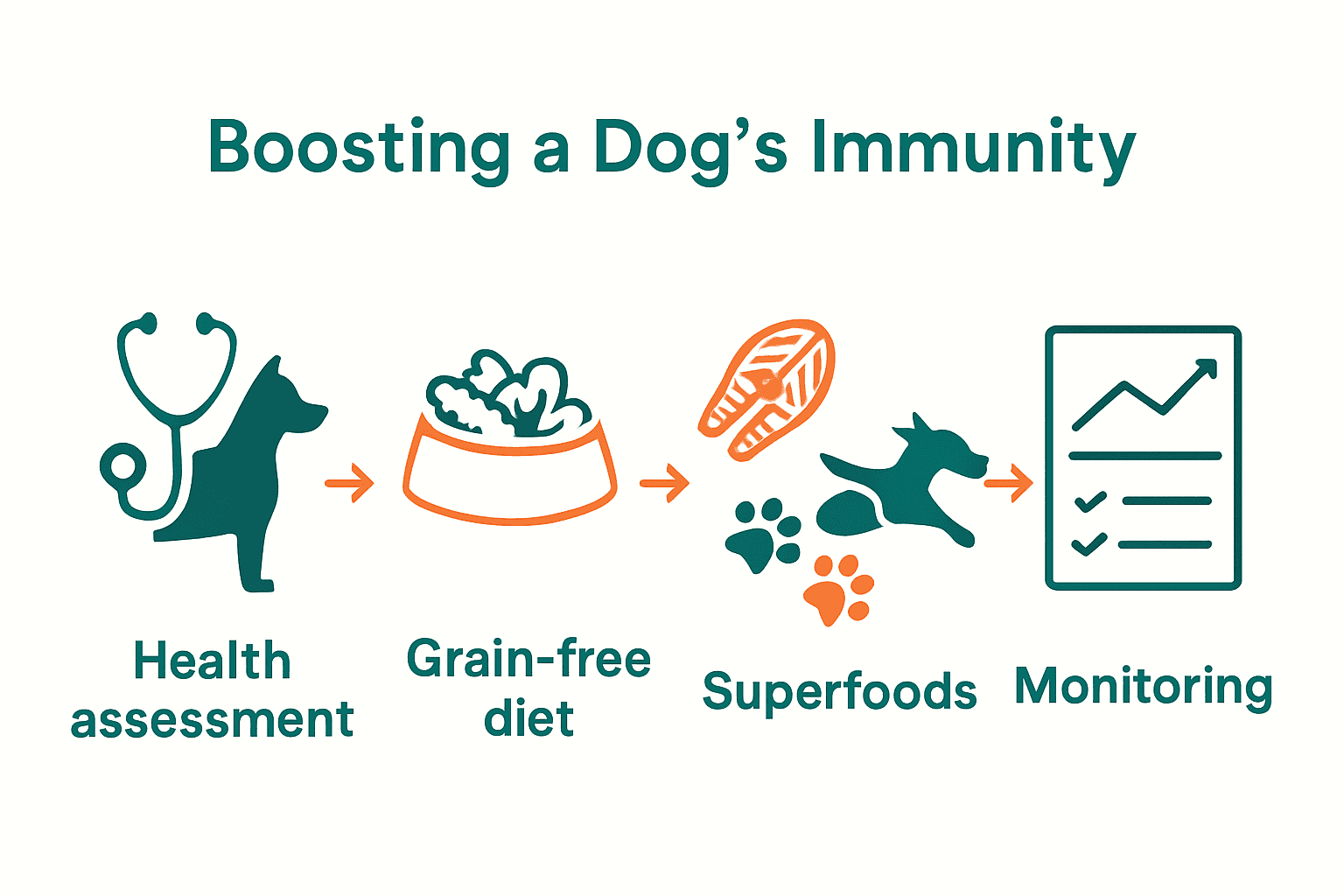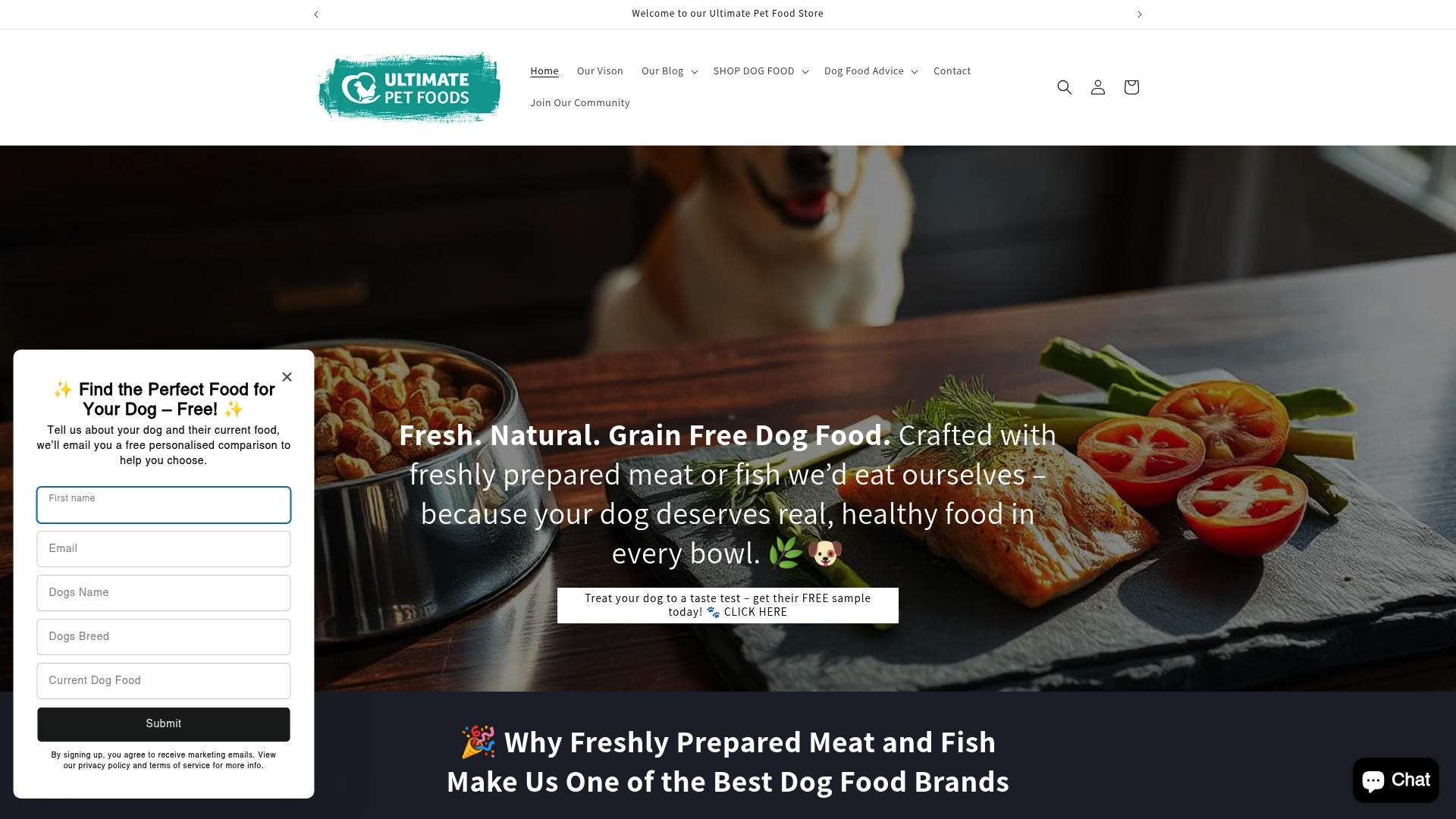
How to Boost Dog Immunity Naturally for Optimal Health
Share
Most british pet owners want their dogs to live longer, healthier lives, yet only a small percentage truly track every aspect of their pets’ health and nutrition. The right choices can make a powerful difference, from spotting early signs of immune weakness to choosing food that fits your dog’s needs. This guide lays out practical, science-backed steps to help you boost your dog’s immunity and support their well-being from the inside out.
Table of Contents
- Step 1: Assess Your Dog’s Current Health and Immunity
- Step 2: Switch to a Natural, Grain-Free Diet
- Step 3: Incorporate Immune-Boosting Superfoods
- Step 4: Enhance Lifestyle with Regular Exercise and Enrichment
- Step 5: Monitor Progress and Adjust Nutrition as Needed
Quick Summary
| Key Insight | Explanation |
|---|---|
| 1. Assess your dog’s health regularly | Regular health assessments help identify early signs of immunity issues and overall well-being. Monitor energy levels, coat condition, and digestive health for changes. |
| 2. Gradually transition to grain-free diet | Introduce grain-free food slowly (25% new to 75% old) over 7-10 days to prevent digestive issues and ensure proper adaptation. |
| 3. Incorporate immune-boosting superfoods | Add powerful ingredients like salmon, blueberries, and spinach to support immune health and provide essential nutrients for your dog. |
| 4. Establish a structured exercise routine | Engage your dog in at least 30-60 minutes of daily physical and mental activities to enhance their immune function and overall fitness. |
| 5. Monitor your dog’s progress continuously | Keep a weekly log of health indicators and consult your veterinarian every few months to make nutritional adjustments based on observed changes. |

Step 1: Assess Your Dog’s Current Health and Immunity
Understanding your dog’s baseline health is crucial for creating a targeted immunity boosting strategy. This initial assessment involves carefully observing your dog’s overall physical condition, energy levels, and potential signs of underlying health challenges.
Start by conducting a comprehensive visual and physical examination. Check your dog’s coat for shine and thickness, which can indicate nutritional status and immune system health. Look for signs like excessive shedding, dull fur, skin irritations, or persistent scratching that might suggest compromised immunity. Examine their eyes for clarity and brightness, gums for healthy pink coloration, and observe their energy levels throughout the day.
A thorough assessment also includes monitoring your dog’s digestive health and tracking any recurring issues. Watch for symptoms such as irregular bowel movements, occasional vomiting, or changes in appetite. These can be early indicators of immune system challenges. Consider tracking dog foods that support holistic nutrition to help strengthen your pet’s natural defences.
If you notice persistent health concerns or significant changes in your dog’s condition, consulting with a veterinary professional is recommended for a comprehensive health evaluation and personalised guidance.

Step 2: Switch to a Natural, Grain-Free Diet
Transitioning your dog to a natural, grain-free diet requires thoughtful planning and understanding of your pet’s unique nutritional needs. While grain-free diets have gained popularity, research from Which suggests that not all dogs require grain elimination, making it crucial to approach this dietary change carefully.
Begin by gradually introducing grain-free food into your dog’s diet. Start with a 25% new diet mixed with 75% current food, slowly increasing the proportion over 7-10 days. This gradual transition helps prevent digestive upset and allows your dog’s system to adapt. Look for grain-free options that contain high-quality proteins like freshly prepared meat or fish, which provide essential amino acids and support muscle development.
According to the British Veterinary Association, it is essential to ensure that grain-free diets are carefully formulated to provide complete nutritional balance. Understanding the benefits of grain-free diets can help you make informed choices about your dog’s nutrition.
Watch your dog closely during the transition. Monitor their energy levels, coat condition, and overall health.
If you notice any adverse reactions or concerns, consult your veterinarian to ensure the new diet meets your dog’s specific nutritional requirements.
Step 3: Incorporate Immune-Boosting Superfoods
Strengthening your dog’s immune system through strategic nutrition involves introducing powerful superfoods that naturally enhance their body’s defence mechanisms. While specific research is limited, veterinary nutritionists recommend several nutrient-dense ingredients that can support your dog’s overall health and immune function.
Begin by incorporating key superfoods into your dog’s diet. Lean proteins like salmon provide omega-3 fatty acids that reduce inflammation and support immune responses. Blueberries are packed with antioxidants that help combat free radicals, while pumpkin seeds offer zinc and essential minerals crucial for immune system maintenance. Dark leafy greens such as spinach can provide vitamins A, C, and K, which help bolster cellular protection. Consider adding immune-supporting dog treats that contain these beneficial ingredients to make supplementation easier.
When introducing new superfoods, start with small quantities and observe your dog’s reaction. Gradually increase portions to allow their digestive system to adapt. Always consult with your veterinarian before making significant dietary changes, especially if your dog has pre-existing health conditions or specific nutritional requirements. Remember that a balanced approach combining high-quality nutrition, regular exercise, and preventative care provides the most comprehensive support for your dog’s immune health.
Step 4: Enhance Lifestyle with Regular Exercise and Enrichment
Research from ArXiv reveals that monitoring and adjusting a dog’s activity levels can significantly impact their overall health and well-being. Developing a comprehensive exercise and enrichment routine is crucial for boosting your dog’s immune system, mental stimulation, and physical fitness.
Begin by creating a structured exercise plan tailored to your dog’s age, breed, and energy level. Aim for at least 30-60 minutes of daily activity, which can include walks, fetch, swimming, or interactive play sessions. Incorporate mental stimulation through puzzle toys, training exercises, and sensory exploration. Studies on free-ranging dogs suggest that social interactions and varied activities are essential for maintaining optimal health.
Rotate activities to keep your dog engaged and prevent boredom. Consider activities like agility training, nose work, or group play dates that challenge both physical and mental capabilities. Monitor your dog’s response to different activities, adjusting intensity and duration as needed. A balanced approach that combines physical exercise, mental challenges, and social interaction will help strengthen your dog’s immune system and overall vitality.
Step 5: Monitor Progress and Adjust Nutrition as Needed
Emerging research in smart computing technologies highlights the importance of continuous health monitoring for dogs, making it crucial to regularly assess and adapt your pet’s nutritional strategy. Understanding how your dog responds to dietary changes requires a comprehensive approach that goes beyond simple observation.
Begin by tracking key health indicators such as energy levels, coat condition, weight, and overall vitality. Research emphasizes the need to use multiple physiological indicators to accurately assess canine welfare. Create a weekly log documenting your dog’s weight, appetite, digestive health, and activity levels. When transitioning dog foods, follow expert guidance on making nutritional adjustments to ensure a smooth and effective dietary progression.
Consult with your veterinarian every three to six months to review your dog’s health metrics and make necessary nutritional refinements. Be prepared to adjust portion sizes, protein levels, or supplement intake based on your dog’s changing needs. Pay attention to subtle changes in energy, skin health, and digestive performance as indicators of nutritional effectiveness. Remember that optimal nutrition is an ongoing process of observation, adaptation, and personalised care.
Strengthen Your Dog’s Natural Defences with Targeted Nutrition
Boosting your dog’s immunity naturally starts with understanding their unique needs and providing nutrition that supports their health at every stage of life. If you are concerned about compromised immunity or want to enhance your dog’s vitality and resilience, choosing high-quality, grain-free diets made from fresh ingredients is a vital first step. Your dog deserves food that not only tastes great but also nurtures their coat, digestive health and overall energy.

Explore our comprehensive collections of natural, carefully balanced dog foods crafted to support immune health. Whether your dog is young, senior or facing specific health challenges you will find options tailored to enhance their wellbeing. Act now to take advantage of our Discount 15% Offer for Our Sample customers and start your dog on a journey to stronger immunity and optimal health today. Visit https://ultimatepetfoods.co.uk to discover how premium nutrition can transform your dog’s life.
Frequently Asked Questions
How can I assess my dog’s current health to boost their immunity?
To assess your dog’s current health, conduct a visual examination checking their coat, eyes, and gums, and monitor their energy levels and digestive health. Note any signs of dull fur, excessive shedding, or changes in appetite, and take action by consulting your veterinarian if concerns arise.
What should I consider when switching my dog to a natural, grain-free diet?
When switching to a natural, grain-free diet, gradually mix in the new food over 7-10 days to prevent digestive upset. Start with 25% of the new food and increase to 100% while monitoring your dog for any adverse reactions.
Which superfoods can I add to my dog’s diet for immune support?
Incorporate superfoods like salmon, blueberries, pumpkin seeds, and dark leafy greens into your dog’s diet to enhance their immune system. Begin by introducing small amounts and gradually increase the portions while observing your dog’s reaction.
How much exercise should I provide to improve my dog’s immune health?
Aim for at least 30-60 minutes of physical activity each day to enhance your dog’s immune health. Include a mix of walks, playtime, and mental stimulation through puzzle toys to promote overall well-being.
How can I monitor my dog’s progress after dietary changes?
Track key health indicators such as weight, energy levels, and coat condition to monitor your dog’s progress after dietary changes. Keep a log of these indicators weekly and consult your veterinarian every three to six months to adjust their nutrition as needed.
What are the signs that my dog’s immune system needs support?
Signs that your dog’s immune system may need support include persistent dull fur, frequent infections, changes in appetite, or unusual lethargy. Take action by assessing their health and consulting a veterinary professional for tailored advice.
Recommended
- Immune -Wellness Dog Treat to Aid and Support The Dogs Immune System. – Ultimate Pet Foods
- Understanding Dog Food for Skin Issues – Ultimate Pet Foods
- Understanding the Best Dog Food for Sensitive Dogs – Ultimate Pet Foods
- Understanding Holistic Dog Nutrition for Healthier Pets – Ultimate Pet Foods
- Wat zijn de belangrijkste vitamines voor honden? – Purepaws
